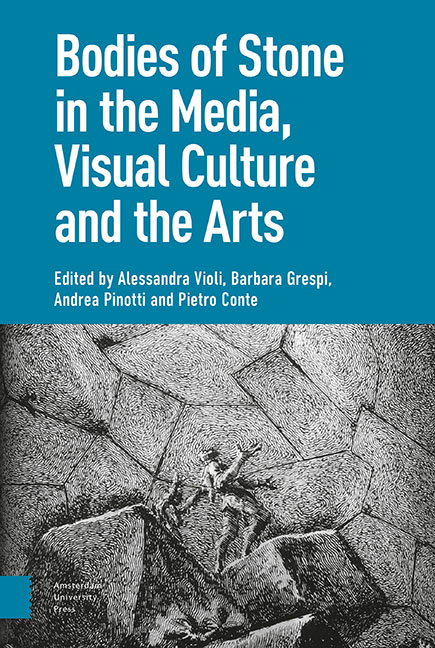Book contents
- Frontmatter
- Contents
- Introduction: Learning from Stone
- I Statue: The Imaginary of Uncertain Petrification
- 1 Theatre and Memory: The Body-as-Statue in Early Modern Culture
- 2 Translated Bodies: A ‘Cartographic’ Approach
- 3 Pantomime in Stone: Performance of the Pose and Animal Camouflage
- 4 Animated Statues and Petrified Bodies: A Journey Inside Fantasy Cinema
- 5 The Ephemeral Cathedral: Bodies of Stone and Configurations of Film
- II Matter: Size, Hardness, Duration
- 1 Bodies That Matter: Miniaturisation and the Origin(s) of ‘Art’
- 2 Brancusi’s ‘Sculpture for the Blind’
- 3 Cinema, Phenomenology and Hyperrealism
- 4 Ephemeral Bodies: The ‘Candles’ of Urs Fischer
- 5 The Celluloid and the Death Mask: Bazin’s and Eisenstein’s Image Anthropology
- III Corpse: Fossils, Auto-Icons, Revenants
- 1 Funeral Eulogy: Post-Mortem Figures and Redeemed Bodies, in Images
- 2 On Jack Torrance As a Fossil Form
- 3 Technical Images and the Transformation of Matter in Eighteenth-Century Tuscany
- 4 Glass, Mixed Media, Stone: The Bodily Stuffs of Suspended Animation
- 5 Bodies’ Strange Stories: Les Revenants and The Leftovers
- IV Monument: Embodying and Grafting
- 1 The Impassibly Fleshly, the Statue of the Impossible
- 2 Frozen into Allegory: Cleopatra’s Cultural Survival
- 3 The Orphan Image
- 4 The Well-Tempered Memorial: Abstraction, Anthropomorphism, Embodiment
- 5 Monuments of the Heart: Living Tombs and Organic Memories in Contemporary Culture
- Index
2 - Brancusi’s ‘Sculpture for the Blind’
Published online by Cambridge University Press: 20 November 2020
- Frontmatter
- Contents
- Introduction: Learning from Stone
- I Statue: The Imaginary of Uncertain Petrification
- 1 Theatre and Memory: The Body-as-Statue in Early Modern Culture
- 2 Translated Bodies: A ‘Cartographic’ Approach
- 3 Pantomime in Stone: Performance of the Pose and Animal Camouflage
- 4 Animated Statues and Petrified Bodies: A Journey Inside Fantasy Cinema
- 5 The Ephemeral Cathedral: Bodies of Stone and Configurations of Film
- II Matter: Size, Hardness, Duration
- 1 Bodies That Matter: Miniaturisation and the Origin(s) of ‘Art’
- 2 Brancusi’s ‘Sculpture for the Blind’
- 3 Cinema, Phenomenology and Hyperrealism
- 4 Ephemeral Bodies: The ‘Candles’ of Urs Fischer
- 5 The Celluloid and the Death Mask: Bazin’s and Eisenstein’s Image Anthropology
- III Corpse: Fossils, Auto-Icons, Revenants
- 1 Funeral Eulogy: Post-Mortem Figures and Redeemed Bodies, in Images
- 2 On Jack Torrance As a Fossil Form
- 3 Technical Images and the Transformation of Matter in Eighteenth-Century Tuscany
- 4 Glass, Mixed Media, Stone: The Bodily Stuffs of Suspended Animation
- 5 Bodies’ Strange Stories: Les Revenants and The Leftovers
- IV Monument: Embodying and Grafting
- 1 The Impassibly Fleshly, the Statue of the Impossible
- 2 Frozen into Allegory: Cleopatra’s Cultural Survival
- 3 The Orphan Image
- 4 The Well-Tempered Memorial: Abstraction, Anthropomorphism, Embodiment
- 5 Monuments of the Heart: Living Tombs and Organic Memories in Contemporary Culture
- Index
Summary
Abstract
One of the lesser-known works by Brancusi, Sculpture for the Blindis actually a key work, paradigmatic of the artist's entire output. Perfectly oval in shape, it is the endpoint of Brancusi's trajectory towards abstraction, which leads from the head to the egg as a symbol of origin. But, destined for the “blind”, on the one hand it displaces fruition from sight to touch, highlighting the importance of this modality also for other works; on the other hand it indicates the importance of “blinding” for understanding art; finally it denounces in its own way the blindness of so many self-styled art users. The essay reconstructs the history of the sculpture, its interpretations and its further implications.
Keywords: Brancusi; sculpture; blindness; egg; perception
Sculpture for the Blindis one of Constantin Brancusi's less well-known—or at least less discussed—works. Nevertheless, it lies at the heart of several important open questions. Among the reasons for its relative neglect may be the difficulty it poses for art historians because the documents that regard it are few, fragmentary and, when not, as some think, actually misleading, in part unreliable or controversial. On the other hand, if we take the title literally, it raises nothing less than the question of blindness, which is an intriguing problem for art.
The first version of the sculpture, in marble, dates to 1916 and was presented at the Independents’ Exhibitionin New York the following year. This must be the same as the piece that Brancusi sold to the collector John Quinn in 1922, that then, in 1935, passed with Duchamp's mediation to the Arensberg Collection and that is now in the Philadelphia Museum of Art. A second version is dated to 1925; it is in alabaster and was first presented at the Salon des Indépendentsin Paris in 1926 and then at the Brummer Gallery in New York in 1933; it is now in the Atelier Brancusi in Paris. All other information is yet more uncertain.
The first version is the object of the most controversial testimony. This is Henri-Pierre Roche's claim that at the Independents’ Exhibitionin New York, it was presented ‘wrapped up in a bag, with two sleeve-holes through which the hands could pass […] and it was a “revelation for the hands” without the eyes, though most of the people thought it must then be a joke’.
- Type
- Chapter
- Information
- Bodies of Stone in the Media, Visual Culture and the Arts , pp. 159 - 168Publisher: Amsterdam University PressPrint publication year: 2020

